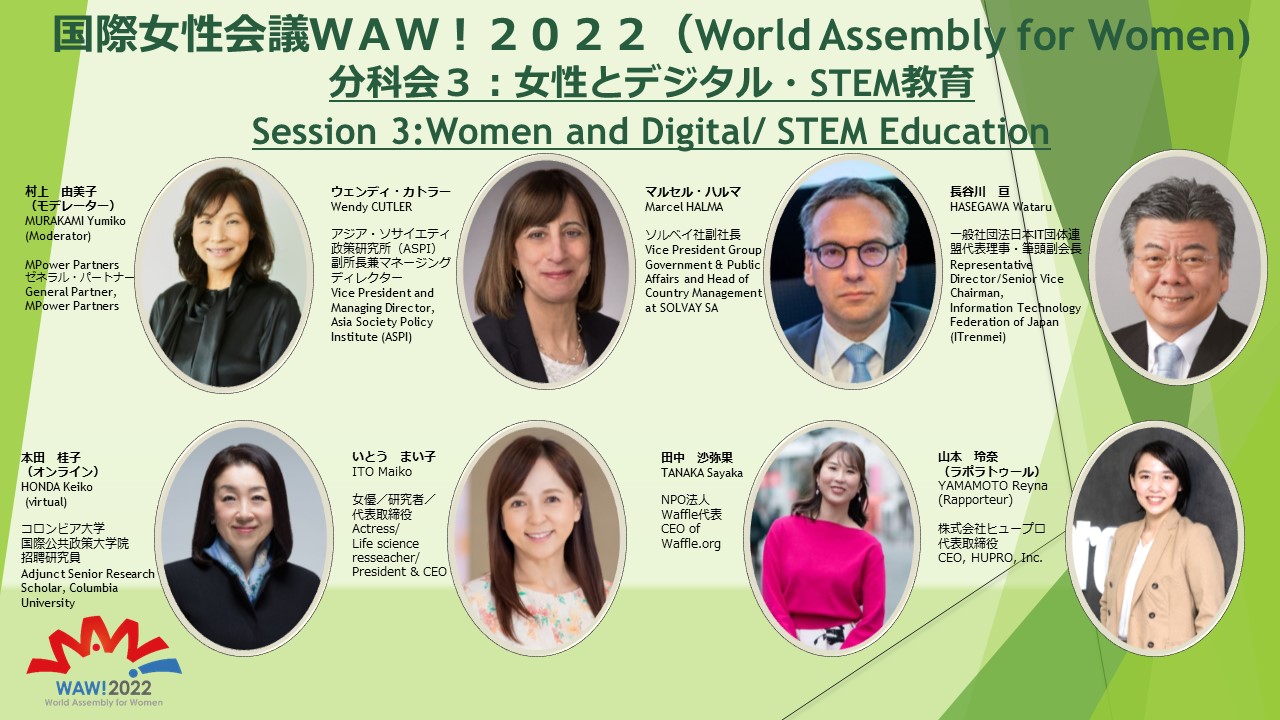Women's Empowerment and Gender Equality
World Assembly for Women: WAW! 2022
Concept Note
Women and Digital/STEM Education
Participants (Regularly Updated)

- MURAKAMI Yumiko, General Partner, MPower Partners (Moderator)
- Wendy CUTLER, Vice President Asia Society Policy Institute
- Marcel HALMA, Vice President Group Government & Public Affairs and Head of Country Management at SOLVAY SA
- HASEGAWA Wataru, Representative Director/Senior Vice Chairman Information Technology Federation of Japan (ITrenmei)
- HONDA Keiko, Adjunct Senior Research Scholar, Columbia University (virtual)
- ITO Maiko, Actress/ Life science resseacher/ President & CEO
- TANAKA Sayaka, CEO of Waffle.org
- YAMAMOTO Reyna, CEO, HUPRO, Inc. (Rapporteur)
Current situation and challenges to be discussed
The use of digital technology, including artificial intelligence (AI) and big data, is advancing, and a digital transformation is underway to transform people's lives(note1). On the other hand, the COVID-19 pandemic highlighted the digital divide between men and women. Digital divide also exists between urban and rural areas, with reports indicating that many of the 3.7 billion people without Internet access are poor, have limited access to education, or are women and girls from rural areas(note2).
On the employment side, there is a growing demand for digital talents(note3).
Against this backdrop, at this year's G7 Summit, leaders recognized the importance of full, equal, and meaningful participation of women in the digital transition. In April of this year, the Government of Japan also adopted the "Women's Digital Human Resource Development Plan(note4) " and has decided to implement measures nationwide through public-private collaboration over the next three years, from supporting women in acquiring basic digital literacy skills to fostering professional human resources with high-level skills.
In the digital field, working conditions and wages vary widely, and some jobs require long working hours, making it difficult for women to participate(note5). A future initiative is to ensure flexibility of work and stable income as the number of women who can become digital professionals increases(note6).
Discussion Topics
- Why has the ratio of women in STEM fields remained stagnant? Is strengthening STEM education for girls only an effective means of achieving the goal? What measures are effective in removing unconscious bias, which is considered one of the reasons for the sluggish growth of the ratio of women in STEM fields?
- Are there any innovative solutions other than STEM education that can be taken to close the gender gap in digitalization among nations, organizations, and societies? What are some of the measures that have worked in practice?
- What institutional design is needed to ensure that the gig economy (a market for short-term labor through online platforms), which is one form of work, serves as a stable source of income for women and guarantees the rights of women working in the gig economy?
- (note1) 塩満典子、“科学技術・イノベーション分野における男女共同参画・ダイバーシティ推進政策の歴史と多様性向上の意義(STIホライズン2022年第8巻1号)” (PDF)
 (Japanese)
(Japanese) - (note2) UN Women, “Learn the facts: Rural women and girls”

- (note3) 男女共同参画会議, “女性デジタル人材育成プラン” (PDF)
 (Japanese)
(Japanese) - (note4) 男女共同参画会議, “女性デジタル人材育成プラン” (PDF)
 (Japanese)
(Japanese) - (note5) 内閣府男女共同参画局, “計画実行・監視専門調査会(第11回)議事録” (PDF)
 p.14 (Japanese)
p.14 (Japanese) - (note6) 内閣府男女共同参画局, “計画実行・監視専門調査会(第11回)議事録” (PDF)
 p.23 (Japanese)
p.23 (Japanese)

